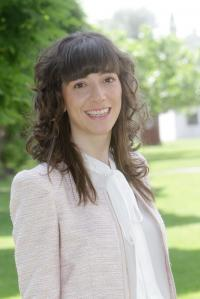Oct 3 2012
Montserrat Fernández-Vallejo, a telecommunications engineer and graduate of the UPNA-Public University of Navarre, has experimentally developed various fibre-optic sensor networks for the remote monitoring of large infrastructures. Specifically, she has managed to develop the largest network so far in existence —measuring 250 km—, which is equipped with a multiplexing capability, (which enables two or more information channels to be combined within a single transmission medium).
 This is Montserrat Fernández Vallejo, telecommunications engineer and graduate of UPNA
This is Montserrat Fernández Vallejo, telecommunications engineer and graduate of UPNA
This technological development in the field of remote communication has enabled new lines of research and a host of practical applications to be opened up. Of particular importance among them is the monitoring of intelligent or large infrastructures for which the sensor networks are of tremendous use. As Montserrat Fernandez points out, "With remote monitoring we can analyse a structure or large infrastructures like marine platforms from a central hub located tens or hundreds of kilometres from the infrastructure to which the sensors send the information without the need for any power source." This log enables measurements of structural or environmental parameters to be obtained, critical states to be observed, the correct maintenance to be provided and possible accidents to be prevented.
Fibre-optics is a transmission medium routinely used in data networks. It consists of a very thin strand of glass or plastic material along which the light that represents the data transmitted is sent. The fibre-optic sensor is a device capable of detecting variations of a parameter thanks to the change that this produces in some of the features of the light. The sensing network comprises a group of sensors placed directly on or very close to the infrastructure that is to be evaluated.
Challenges addressed
The thesis "Contribution to the development of optical networks for fibre Optics sensors using fibre lasers" has been supervised by Professor Manuel López-Amo Sainz, of the Department of Electric and Electronic Engineering of the UPNA-Public University of Navarre; it took top honours and a cum laude distinction, with European Doctorate Mention.
In her research, Montserrat Fernández addressed the three main challenges posed by optic sensor networks: multiplexing sensors in a single network, ensuring continued service in the event of a possible fault in the network, and allowing remote monitoring.
In this work she also developed the longest network so far with a multiplexing capability which extends to 250 kilometres. Multiplexing allows the systems and their cost to be simplified. "With multiplexing," the researcher points out, "firstly, we share the same transmission medium to broadcast information coming from different sources, and secondly, we share the transmitter and the receiver." In the case of remote fibre-optic networks, it is the fibre itself that functions as the medium of transmission: the sensors send the information through it and all the information received is handled at the main hub.
The principal applications of fibre-optic sensor networks are connected with cases in which the structure that needs to be monitored is economically very costly (oil pipelines, high voltage lines), when there is a risk of human loss (nuclear plants, chemical product warehouses, bridges, dams, etc.) or when a perimeter needs to be monitored.
Montserrat Fernández-Vallejo completed her degree in Telecommunications Engineering at the UPNA-Public University of Navarre in 2008. Since then, she has worked as an assistant and collaborator in projects in the Department of Electrical and Electronics Engineering. She did two periods of research: at the Università degli studi di Parma (Italy) in 2009, and at the Institute of Photonic Technology (Jena, Germany) in 2010.
Her PhD thesis has given rise to 15 articles in influential international journals, 12 papers at international conferences and 3 papers at national conferences.